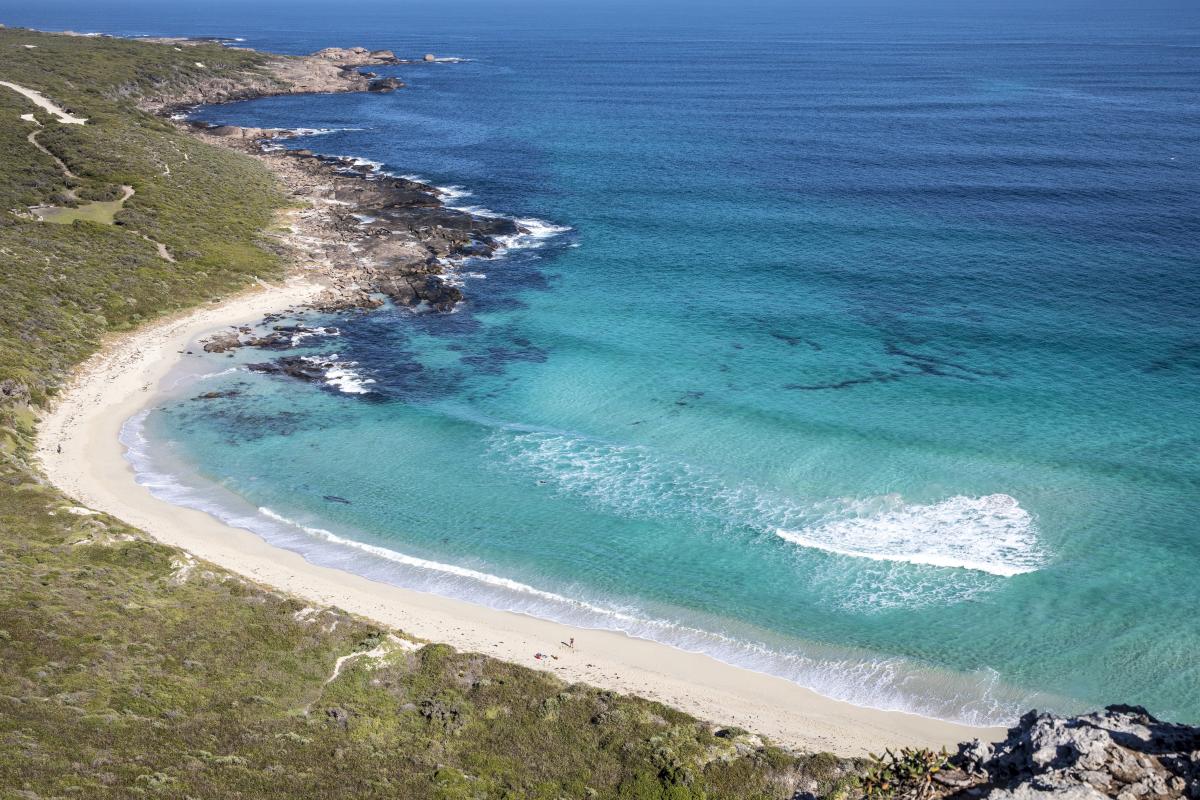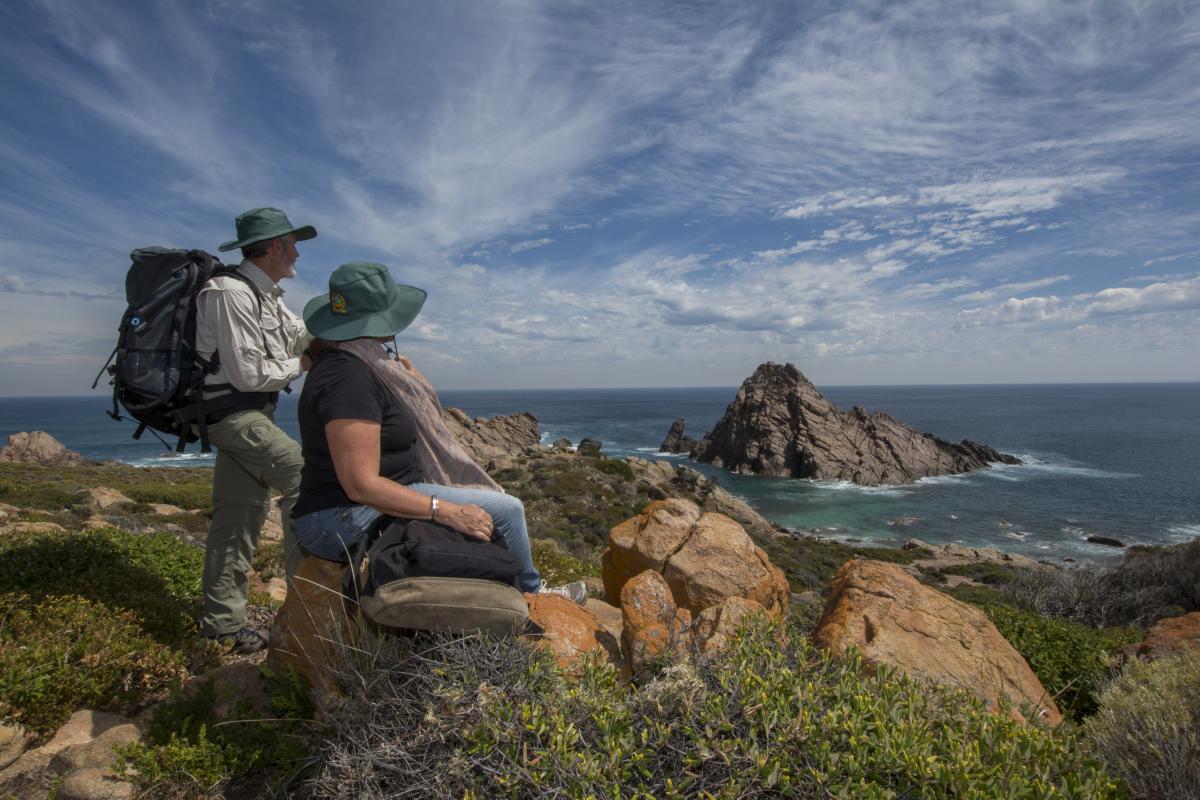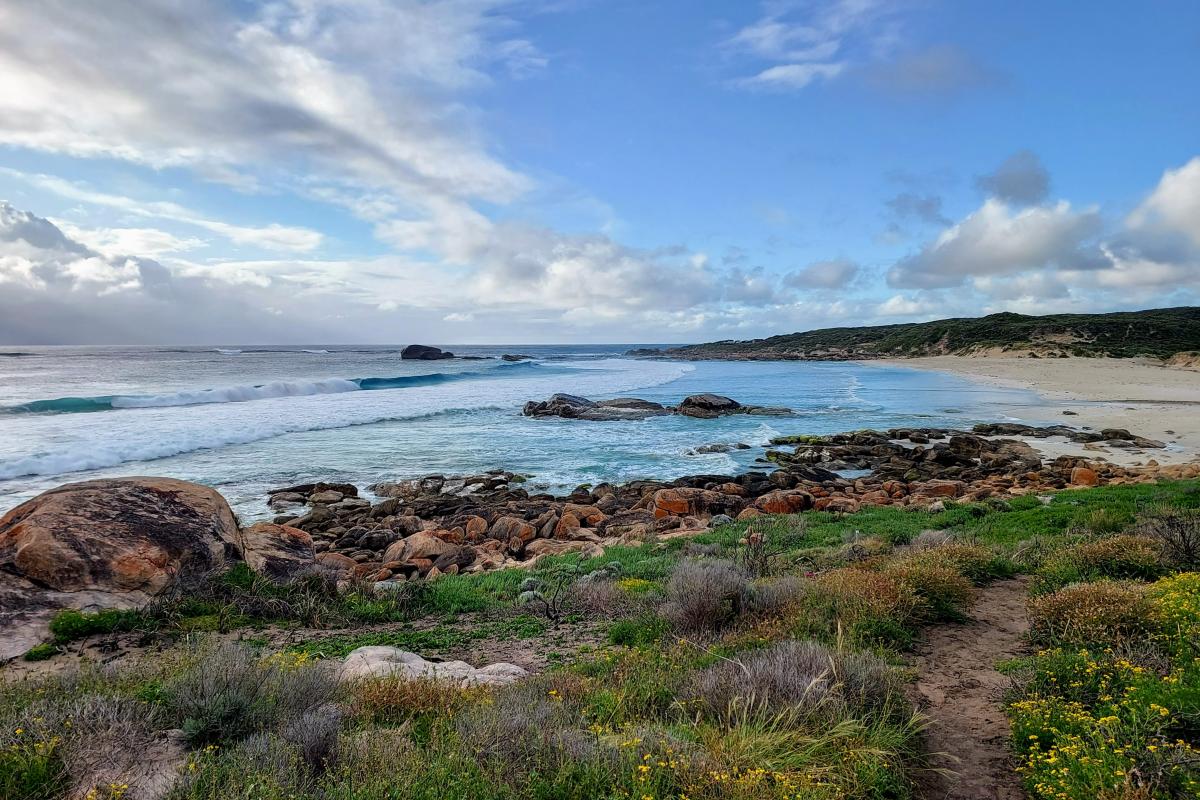The 130km Cape to Cape Track traverses the length of Leeuwin-Naturaliste National Park and overlooks the adjoining Ngari Capes Marine Park, alternating spectacular sweeping cliff-top views with stretches of pristine beach.
At any time of the year there's a good chance of seeing dolphins, and between June and September whales pass close to shore on their annual migration between the Southern Ocean and their breeding areas further north. Most are humpbacks, the species that breaches the surface more than any other, but you may also see southern right whales and, if you're very lucky, a blue whale.
It's not all about the coast though, there are several inland forays which take in some lovely sheltered woodland sections as well as the magnificent Boranup Forest of towering karri.
The Track varies from the 'access for more' section to Cape Naturaliste with a shallow gradient and a smooth, wide constructed surface to steep, rough stony paths and sandy beaches. It is for walkers only - except where the route follows some of the four-wheel drive tracks that are frequented by surfers accessing their favourite breaks at this world-famous surf location.
To tackle the whole track in one trip is a great challenge (usually 5 – 7 days), but multiple vehicle access points allow the Cape to Cape Track to be completed in smaller segments. The overnight options include some very basic camping areas for track walkers only, campgrounds with more facilities and vehicle access and, this being the tourist mecca of the Margaret River wine region, plenty of other accommodation right up to the highest levels of luxury and pampering.
For most of the year the Margaret River, about mid-way along the track, can be crossed with care at its mouth, but there are periods in winter when it is not safe to cross and walkers will have to take an inland diversion to cross at the bridge upstream. The river mouth can be accessed by vehicle at the southern side, but not from the north - walkers from the north have no alternative but to retrace their steps if the river mouth cannot be crossed.
For more on the Cape to Cape Track including guide books and other information, go to the website of our not-for-profit community partner the Friends of the Cape to Cape Track. The friends' coordinates a track adoption program and, along with a number of other operators licensed to provide tours, offers a series of guided walks.
The Track is open year-round, with sea breezes moderating the extreme heat of summer. However, fire danger at this time of year can still be very high, with the wind adding to the risk.
Leeuwin-Naturaliste is one of our most popular parks and part one of the country's most well-known tourist destinations: anyone planning to walk the Cape to Cape Track during peak periods (see Know: When to visit) should book accommodation early, and consider allowing extra travelling time from Perth.
Safety information
- Plan your visits for cooler periods of the year, avoiding the hot summer months.
- Check the Fire Danger Rating and do not go on or remain on the trails if the forecast is Extreme or Catastrophic.
- Do not plan extended multi-day trips beyond the Fire Danger Rating forecast during summer as, due to limited mobile phone coverage, it is not always possible to keep updated with changing conditions.
- Avoid remote sections of the trail where there is limited vehicle access.
- Abide by all trail closure signage, and any instructions from Parks and Wildlife and other emergency staff.
Trails and parks may be closed on days when the Fire Danger Rating is Extreme or Catastrophic. Check these websites when planning your walks:
- Emergency WA – information about Fire Danger Ratings, current warnings and incidents
- Bureau of Meteorology – for weather forecasts and Fire Danger Ratings
Install the free Emergency+ app on your mobile phone and use it in any emergency to call for assistance. If there is no mobile phone coverage you will not be able to call 000 but the app will provide you with GPS location details. Keep your phone fully charged and with location services turned on.n.
Download 'Are you bushfire ready?'
It is recommended that you inform friends, family and/or police of your travel dates and the locations you plan to visit (your itinerary) during your travels into parks and reserves in Western Australia. Provide them with regular updates to ensure they know where you are. Agree on what they should do if you are overdue or do not return when you said you would. Use this form and provide sufficient detail so that they have the information needed to get help if required.
Gallery




Groups on the track
Cape to Cape campsites cannot be reserved but early notification of a groups’ intentions to use campsites enables us to inform other walkers when these facilities will be occupied by those groups.
Download and complete this form, then email it to conto.campground@dbca.wa.gov.au.
If you're planning a school excursion or outdoor education activity, find out all you need to know about group bookings and approvals at Outdoor in education parks and reserves.
Proposed prescribed burns
The Parks and Wildlife Service conducts a year-round program of prescribed burning. These burns are undertaken primarily for property protection, fuel reduction and biodiversity management. To view all proposed prescribed burns check the department's indicative burn plan.
These burns are carefully planned however they may cause some disruptions to walkers and riders. Where prescribed burns impact on the trail, closures and diversions are implemented to ensure the safety of walkers and riders, including temporary camp sites where necessary. These will remain in place until the original trail alignment has been declared safe. For diversions and smoke warnings check Park Alerts
For your safety follow all signs, diversions and instructions from Parks and Wildlife staff and other emergency personnel.
Prescribed burns are dependent on appropriate weather conditions and, as such, burning dates are not available in advance.
Downloadable route files
Download the digital coordinate data for the routes of the State’s three iconic long distance trails, Bibbulmun Track, Cape to Cape Track and Munda Biddi Trail.
Digital coordinates are used to describe waypoints, tracks and routes for software applications on computers and GPS receivers, including some mobile phones. Digital coordinates can be used to visualise a route for planning purposes and for navigation.
The digital routes are available below in two formats to make them accessible for a wide group of users.
The GPX, also known as GPS Exchange Format, is a common GPS format for storing and using coordinate data in a way that is easy to use, process and convert to other forms. GPX files can be used by GPS receivers and some mapping programs. Keyhole Markup Language (KML) was developed for use with internet-based Google Earth and Google Maps for expressing geographic visualization within two or three dimensional maps. Many mobile phones are fitted with a GPS receiver, which can utilise KML files via its apps.
This downloadable route data is for visual representation during trip planning and is not intended as a navigation tool. Remember to carry hard-copy maps and a compass with you at all times (and know how to use them). Do not rely on any electronic equipment – batteries might expire, the device might fail or break, and can be unreliable under trees.
This alignment data does not include diversions. Follow all on-ground diversion signage – these are in place for your safety. Downloadable GPX and KML files of the trail alignments can be accessed from the Western Australian Government Open Data website.
The route data will be updated as changes are made to the alignment. Check back regularly to ensure that you have the most current version. If you find errors please let us know by calling (08) 9219 8265 or emailing recreationandtrails@dbca.wa.gov.au.
Disclaimer: By downloading this GPX or KML file you agree its use, and reliance upon, is entirely at your own risk. These files are for non-commercial, personal use only. The Department of Biodiversity, Conservation and Attractions' Parks and Wildlife Service endeavoured to ensure the accuracy and currency of the data, but accepts no responsibility in this regard, or the results of any actions taken, when using the digital route files.
FAQ's
Weather – Plan your visits for cooler periods of the year, avoiding the extreme summer temperatures which can rapidly result in dehydration and heat exhaustion. Stay off the trails during severe weather to avoid risks from falling branches and flooding. Expect logs and flooding across the trails for some time afterwards.
Campfires - are not permitted at Cape to Cape Track and Munda Biddi Trail campsites. For the Bibbulmun Track, campfires are generally permitted at most campsites north of Pingerup Road (map 6). They are never permitted south of Pingerup Road and at Yourdamung (map 3) and Blackwood (map 4) campsites as these are in higher fire risk areas. During the summer months all campfires are prohibited, generally between December and April. Use fuel stoves for cooking. Total campfire bans are now in place along the Munda Biddi Trail and Bibbulmun Track. For more information visit Park Alerts.
Prescribed Burns - in the southwest these are primarily undertaken during spring and autumn. These burns are undertaken for property protection, fuel reduction and biodiversity management. They are carefully planned however they may cause some disruption to visitors. Where prescribed burns impact on trails, closures and diversions are implemented to ensure the safety of walkers and riders, including temporary campsites where necessary. Prescribed burns are dependent on appropriate weather conditions and, as such, specific dates are not available in advance.
Maps - Maps for our long distance trails can be purchased from the online shop; visitor centres; outdoor equipment, book and bike stores and our community trail partners.
Water - Water tanks are provided at campsites but these are rain-fed and therefore it is not possible to guarantee the amount or quality of the water available. It is essential that visitors keep an emergency supply of drinking water as back-up and use available water sparingly. All water should be treated before drinking by boiling for at least one minute, mechanical filtration or chemical treatment.
Vehicle Access – Vehicles are not permitted on the Bibbulmun Track, Cape to Cape Track and Munda Biddi Trail. Recommended vehicle access points with parking are marked on the maps with red car symbols.
Transport – Public buses service some of the towns along the Track. Check Transwa for details. There are regular flights between Perth and Albany. Some tourism providers offer transport services details of which can be found on the Bibbulmun Track Foundation’s website.
Groups - Any non-commercial groups with eight or more members, that are staying overnight at Bibbulmun Track, Munda Biddi Trail or Cape to Cape Track campsites please read information at Group Notifications. Commercial groups should click here. For information on the track conditions click here.
Consider universal planning and safety information and apply the Leave No Trace principles.
Trail conditions and diversions
Occasionally temporary trail closures are necessary due to maintenance, prescribed burns, bushfires or severe weather. If part of the trail is closed, a diversion may be marked and signage placed at either end. Check the current conditions in the area you are walking or cycling.
Information below is updated during business hours. More up-to-date information is available from the Parks and Wildlife office closest to the area you are planning to visit.
Facilities
Toilet
Traditional Owners
We recognise and acknowledge Aboriginal people as the Traditional Owners of Cape to Cape Track.